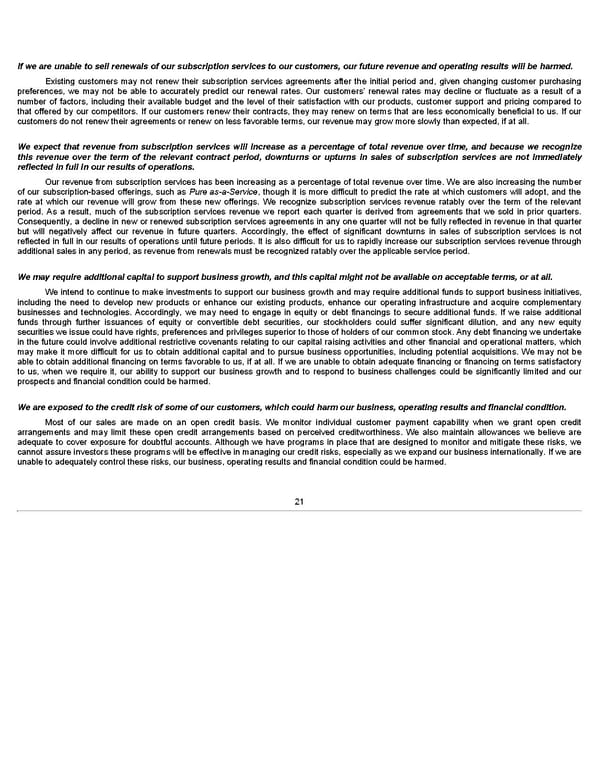If we are unable to sell renewals of our subscription services to our customers, our future revenue and operating results will be harmed. Existing customers may not renew their subscription services agreements after the initial period and, given changing customer purchasing preferences, we may not be able to accurately predict our renewal rates. Our customers’ renewal rates may decline or fluctuate as a result of a number of factors, including their available budget and the level of their satisfaction with our products, customer support and pricing compared to that offered by our competitors. If our customers renew their contracts, they may renew on terms that are less economically beneficial to us. If our customers do not renew their agreements or renew on less favorable terms, our revenue may grow more slowly than expected, if at all. We expect that revenue from subscription services will increase as a percentage of total revenue over time, and because we recognize this revenue over the term of the relevant contract period, downturns or upturns in sales of subscription services are not immediately reflected in full in our results of operations. Our revenue from subscription services has been increasing as a percentage of total revenue over time. We are also increasing the number of our subscription-based offerings, such as Pure as-a-Service, though it is more difficult to predict the rate at which customers will adopt, and the rate at which our revenue will grow from these new offerings. We recognize subscription services revenue ratably over the term of the relevant period. As a result, much of the subscription services revenue we report each quarter is derived from agreements that we sold in prior quarters. Consequently, a decline in new or renewed subscription services agreements in any one quarter will not be fully reflected in revenue in that quarter but will negatively affect our revenue in future quarters. Accordingly, the effect of significant downturns in sales of subscription services is not reflected in full in our results of operations until future periods. It is also difficult for us to rapidly increase our subscription services revenue through additional sales in any period, as revenue from renewals must be recognized ratably over the applicable service period. We may require additional capital to support business growth, and this capital might not be available on acceptable terms, or at all. We intend to continue to make investments to support our business growth and may require additional funds to support business initiatives, including the need to develop new products or enhance our existing products, enhance our operating infrastructure and acquire complementary businesses and technologies. Accordingly, we may need to engage in equity or debt financings to secure additional funds. If we raise additional funds through further issuances of equity or convertible debt securities, our stockholders could suffer significant dilution, and any new equity securities we issue could have rights, preferences and privileges superior to those of holders of our common stock. Any debt financing we undertake in the future could involve additional restrictive covenants relating to our capital raising activities and other financial and operational matters, which may make it more difficult for us to obtain additional capital and to pursue business opportunities, including potential acquisitions. We may not be able to obtain additional financing on terms favorable to us, if at all. If we are unable to obtain adequate financing or financing on terms satisfactory to us, when we require it, our ability to support our business growth and to respond to business challenges could be significantly limited and our prospects and financial condition could be harmed. We are exposed to the credit risk of some of our customers, which could harm our business, operating results and financial condition. Most of our sales are made on an open credit basis. We monitor individual customer payment capability when we grant open credit arrangements and may limit these open credit arrangements based on perceived creditworthiness. We also maintain allowances we believe are adequate to cover exposure for doubtful accounts. Although we have programs in place that are designed to monitor and mitigate these risks, we cannot assure investors these programs will be effective in managing our credit risks, especially as we expand our business internationally. If we are unable to adequately control these risks, our business, operating results and financial condition could be harmed. 21
 Annua lReport Page 20 Page 22
Annua lReport Page 20 Page 22